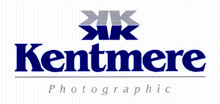
KENTMERE
Fineprint VC
Three unique alternatives for the discerning image
maker seeking the aesthetic qualities of a fibre based paper,
coupled with the convenience of a variable contrast emulsion.
Cool rich blacks, crisp bright whites and exceptional
mid-tone detail characterise Fineprint VC Glossy and finegrain.
Kentmere's unique bromo-iodide technology, with its special
construction, offers superior sharpness with separation in
even the finest detail.
The range is now extended with Fineprint F.(3. Warmtone.
Warm rich whites and a subtle, warmer image rendition characterise
this new paper, complemented by its Finegrain semi matt surface.
All three surfaces respond superbly to many toning techniques
allowing further manipulation of tone and contrast.
Whatever your needs, Fineprint VC is the perfect
choice for portfolio, exhibition and commercial work where
excellence is the criterion.
Product description
The Fineprint VC range consists of black and white enlarging papers
with a traditional fibre base, coated with a variable contrast emulsion.
Using standard colour filtration, contrast from grades 00 to 5 are achievable
in half grade steps.
Surfaces
-
Glossy: The traditional unglazed glossy surface is particularly suited
to portrait, landscape and exhibition work. A very high gloss can be achieved
by standard glazing techniques.
-
Finegrain: A semi-matt surface coated on a Stipple / Lustre base paper.
-
F.G. Warmtone: A new warmtone semi- matt finegrain surface, giving a warm,
rich image with subtle creamy highlights.
Product Identification
Fineprint VC labelling contains the following information:
-
Colour coding: Silver for the Fineprint range.
-
Paper surface: Glossy, Finegrain or F.G. Warmtone.
-
Paper base weight: D.Wt. (double weight).
-
Recommended safelights: Ilford 902, Kodak OC or similar.
Packaging
Kentmere black and white photographic papers are packed in a black
plastic envelope, then an outer cardboard box or envelope and finally sealed
with a label and tape. The plastic envelope helps protect the paper
from humidity and fumes as well as being light proof. Although the
black plastic envelope is light proof, we would recommend that it is also
returned to the outer cardboard container before exposure to white light
as small holes can develop in the plastic envelope with use.
Storage
All Kentmere black and white photographic papers should be stored in
their original packaging, including the black plastic envelope. The 'plastic
envelope protects the paper from harmful darkroom fumes and humidity. Ideally
the paper should be stored in a cool dry environment preferably at temperatures
below 20C. For prolonged storage a freezer can be used. In either case,
allow sufficient time for warming up and do not allow condensation to form
on the paper.
Paper Structure
Paper Base
The paper is 240 g/m2 coated on the front side with 36 g/m2 of
baryta giving a base weight of approximately 276 g/m2 and a thickness
of approximately 260 ìm.
Coated emulsion layer
The light-sensitive silver halide emulsion layer has a silver content
of approximately 1 .5 g/m2. This is covered with a gelatine supercoat which
protects the emulsion from stress fogging and physical damage and also
contains a small amount of developing agent.
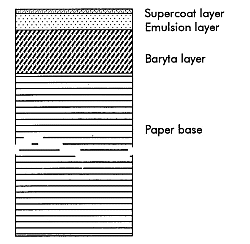
(Not to scale, for information only)
Spectral Sensitivity
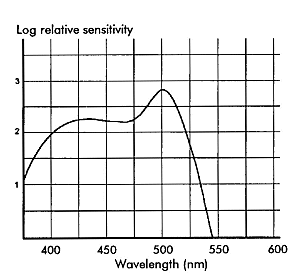
Sensitivity ISO Paper Speed
(ISO speed to ISO 6846 - 1 992)
When exposed to unfiltered white light Fineprint VC has a speed of
ISO P 640 and has a contrast of approximately grade 2. When exposed using
Ilford Multigrade filters grades 00 - 3'/z have the same speed (ISO
P 320) and grades 4 - 5 require approximately twice the exposure (ISO P
1 60). When exposed using the colour enlarger filter settings for matched
exposures (see contrast control) grades 0 - 4 have the same speed (ISO
P 320), grades 00 and 5 require approximately /3 of a stop more exposure
(ISO P 250).
Exposure
Fineprint VC is designed for use with tungsten or tungsten halogen
light sources. Cold light source enlargers can be used, but they may limit
the contrast range achievable.
Contrast Control
Contrast as a range approximately equivalent to grades 00
to 5 is achievable from the Fineprint range by means of colour filters
used in the enlarger. Proprietary filter sets such as Ilford Multigrade
or Kodak Polymax are suitable, as are modular and automatic enlarger heads
featuring proprietary filters; otherwise the magenta and yellow filters
of colour enlarging heads can be used. Below are tables of enlarger colour
filter settings recommended for use with the Fineprint range. Filter settings
recommended by other manufacturers will also give a similar range of contrasts;
there may be slight differences in grade spacings.
The contrast of the paper is continuously variable so that the grades
are fixed only by the filter settings used, and thus fractional grade changes
can be achieved.
Filters of colour enlargers from different manufacturers fall into three
categories as follows:
| Durst: |
Dunco, Durst, Kaiser, Keinzle, Leitz, Lupo. |
| Kodak: |
Beseler, De Vere, Chromega, Fujimoto, IFF, Jobo, LPL,
Omega, Paterson, Vivitar, Simmard. |
| Agfa: |
Agfa, Krokus, Meopta. |
Table A shows simply the filter settings for grade selection. Speeds
of grades are not the same.
| Grade |
Durst |
Kodak |
Agfa |
| 00 |
80Y |
150Y |
140Y |
| 0 |
40Y |
80Y |
90Y |
| 1 |
15Y |
45Y |
60Y |
| 2 |
20M |
10M |
15Y |
| 3 |
40M |
45M |
45M |
| 4 |
60M |
75M |
75M |
| 5 |
130M |
130M |
120M |
When exposed with no filter, the paper gives a contrast
of approximately Grade 2 and is of high speed.
Table B shows the combined filter setting which should
be used if speed matching of grades 0 - 4 is required. Grades 00 and
5 require approximately /3of a stop more exposure.
| Grade |
Durst |
Kodak |
Agfa |
| 0 |
40Y |
80Y |
90Y |
| 1 |
25Y+20M |
60Y+ 15M |
75Y+ 15M |
| 2 |
10Y+45M |
35Y+50M |
50Y+40M |
| 3 |
5Y+50M |
15Y+70M |
25Y+65M |
| 4 |
60M |
5Y+85M |
5Y+85M |
Contrast range
(ISO range to (SO 6846 - 1 992)
Fineprint ISO Range
| Filter |
00 |
0 |
1 |
2 |
3 |
4 |
5 |
| ISO Range |
150 |
130 |
110 |
95 |
80 |
70 |
60 |
These figures represent an average of the achievable results. A small
amount of production tolerance is included. Actual results achieved may
differ depending on processing, paper age and storage conditions.
Maximum density
The Fineprint range will achieve the following maximum densities:
| Glossy |
2.20 |
| Finegrain |
1.60 |
| F.G. Warmtone |
1 .60 |
(the Finegrain surfaces contain matting agents which reduce the maximum
density achievable)
Results achieved using Kentmere VC Select Plus Variable Contrast Developer
at 1 + 12 at 20C as recommended under processing instructions. Other recommended
developers and fixers (see Processing) should give comparable results.
Density/Characteristic curves
(Glossy surface)
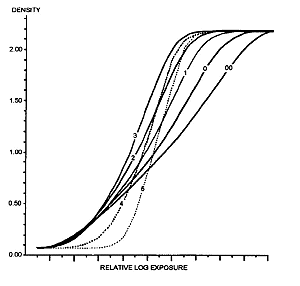
Results achieved using Kentmere VC Select Plus Variable Contrast Developer
at 1 + 12 at 20C as recommended under processing , instructions. Other
recommended developers and fixers (ee Processing) should give comparable
results.
Safelighting
The Fineprint range have orthochromatic emulsions; these require
a dark orange/brown or red safelight to be used. All variable contrast
papers are more sensitive to safelights than conventional graded
printing papers. Good darkroom practices should be adopted, keeping safelight
exposure to a minimum and returning unused paper to the original packaging.
Box/lantern type safelights using glass filters should only be used
with a 15 W bulb or less and should be positioned at (east 1 metre from
the paper. Filters which are suitable for use with the Fineprint range
are :
Kodak OC or 1A, and Ilford 902.
Fluorescent safelights are also suitable, these give a brighter, overall
more even lighting. Fluorescent safelights can produce a more evenly lit
and pleasant working environment, but still be as safe as the conventional
lantern type safelights. Fluorescent safelights should be positioned at
least 1.5 metres from the paper. Fluorescent safelights which are suitable
for use with the Fineprint range are : EncapSulite A 1 0/ND.4 Amber
or R 1 0 Red. (EncapSulite International Ltd., Youngs Trading Estate,
Leighton Buzzard LU7 8QF. Tel O1 525 376974).
Other safelights can be used, but tests should always be carried out
first.
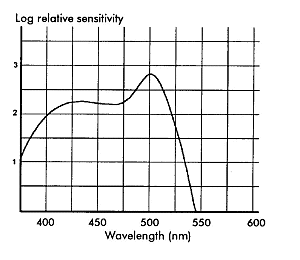
Processing
To maximise d. max, grade spacing and tonal rendition, a multicontrast
chemical system such as Kentmere VC Select Plus Developer and Fixer, especially
formulated to enhance variable contrast emulsions' characteristics, is
recommended. Also recommended, in alphabetical order are Agfa Multicontrast,
Champion B&W Multicontrast, Ilford Multigrade, Kodak Polymax, and Tetenal
Variospeed developers, together with their appropriate fixers. Equivalent
products from other manufacturers should give similar results.
We do not recommend conventional manual developers, which tend to inhibit
both d. max and contrast.
The following table shows recommended dish processing conditions for
use with Kentmere VC Select Plus Varaible Contrast Developer and Fixer.
If using another manufactured s chemistry, refer to their instructions
for recommended processing conditions, to achieve similar results.
| Chemistry |
Dilution |
Temp. |
Time |
Kentmere VC Select Plus Variable Contrast
Developer |
1 + 6
1 + 9
1 + 12
|
20C '
20C
20C
|
60 - 80 s
90 - 1 10 s
1 00 - 1 20 s
|
| 2% Acetic acid stop bath |
- |
20C |
1 0 s |
Kentmere VC Select Plus Variable Contrast
Fixer |
1 + 4
1 + 9 |
20C
20C |
90 - 1 80 s
120 - 240 s |
| Wash in running water |
- |
- |
30 - 40 mins |
Drying
The Fineprint range can be dried using any standard fibre base
paper drying methods, these include;
Atmospheric drying, either at room temperature or using warm air, having
removed excess surface water using a suitable print squeegee. Prints will
dry flatter if hung back to back in pairs. Print drying racks or plastic
mesh screens can also be used to hold prints flat during drying.
Rotary glazing/drying drums or flat bed glazing/drying presses.
The use of a wetting agent in the final washing will help to produce
a better contact between the print face and the heated glazing surface.
If using a heated glazing surface for drying prints, back of print to the
glazing surface, excessive temperatures should not be used, as this can
cause the emulsion to melt and adhere to the glazer blanket.
Toning
The Fineprint range tones well with Kentmere Sepia Toner. Kentmere
Sepia Toner offers infinitely variable tones, according to dilution and
time.
Prints to be toned should be thoroughly fixed and washed prior to any
toning.
Kentmere Sepia Toner comes as parts A + B : a bleach and
toner. By varying the dilution of the toner a range of tones can be obtained.
Used neat a rich chocolate colour is produced, the colour moving towards
yellow/brown with increasing dilution.
Method
-
Immerse print in the bleach'A' solution until all the black image is bleached.
-
Wash in water until the water is no longer coloured.
-
Tone in solution'B' diluted as required.
-
Wash for 30 minutes in running water.
Detailed technical sheets covering toning and cross-processing of our product
range are available separately.
Mounting
The Fineprint range can be mounted using any of the standard methods
for fibre based papers.
-
Cold adhesive films/cold mounting
-
Hot adhesive films/dry mounting
-
Spray adhesives such as:-
3M Spray Mount Adhesive
3M Photo Mount Adhesive
Technical enquiries
Please address any technical enquiries to; Kentmere Limited Photographic
Division, Staveley, Kendal, Cumbria LA8 9P8.
Tel: O1 539 821 365 Fax: 01539 821 399
Replacements
Kentmere Limited will replace or credit the value of any Kentmere
papers if found by us to be defective in manufacture, our liability being
confined to the value of the paper only. In all such cases, proof that
the paper was defective would be required.
|





